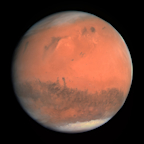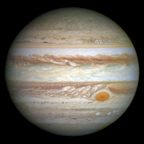Search results
People also ask
What are some interesting facts about Uranus?
What is Uranus made of?
What is the structure of Uranus?
How long is a year on Uranus?
Uranus is the seventh planet from the Sun. It is a gaseous cyan -coloured ice giant. Most of the planet is made of water, ammonia, and methane in a supercritical phase of matter, which in astronomy is called 'ice' or volatiles.
Uranus is the seventh planet from the Sun and the third largest in our solar system. It rotates on its side, has rings, moons, a blue-green atmosphere and a cold core. Learn more about this unique planet from NASA's website.
4 days ago · Uranus, seventh planet in distance from the Sun and the least massive of the solar system ’s four giant, or Jovian, planets, which also include Jupiter, Saturn, and Neptune. At its brightest, Uranus is just visible to the unaided eye as a blue-green point of light. It is designated by the symbol ♅. Hubble Space Telescope: Uranus.
- Uranus was discovered on March 13, 1781, by the English astronomer William Herschel with the aid of a telescope. Uranus is the first planet to be d...
- The mean distance of Uranus from the Sun is nearly 2.9 billion km (1.8 billion miles), more than 19 times as far as Earth, and it never approaches...
- On average, Uranus radiates the same amount of energy as an ideal, perfectly absorbing surface at a temperature of 59.1 kelvins (K; −353 °F, −214 °...
- Uranus has 27 known moons that are accompanied by at least 10 narrow rings. Generally, the rings are located closer to the planet than the moons. S...
- Unlike most planets, the axis of Uranus lies almost parallel to its orbital plane, which means that the planet spins nearly on its side, its poles...
Learn about Uranus, the seventh planet from the Sun, and its unique features such as its tilt, rings, moons, and atmosphere. Find out how Uranus was discovered, named, and explored by spacecraft.
- Uranus was officially discovered by Sir William Herschel in 1781. It is too dim to have been seen by the ancients. At first Herschel thought it was a comet, but several years later it was confirmed as a planet.
- Uranus turns on its axis once every 17 hours, 14 minutes. The planet rotates in a retrograde direction, opposite to the way Earth and most other planets turn.
- Uranus makes one trip around the Sun every 84 Earth years. During some parts of its orbit one or the other of its poles point directly at the Sun and get about 42 years of direct sunlight.
- Uranus is often referred to as an “ice giant” planet. Like the other gas giants, it has a hydrogen upper layer, which has helium mixed in. Below that is an icy “mantle, which surrounds a rock and ice core.
May 6, 2024 · Learn about Uranus, the ice giant that spins on its side and has rings and moons. See pictures, facts, and history of this distant planet.
Learn about Uranus, the seventh planet from the Sun, with the third largest diameter and a unique tilt of 97.77 degrees. Discover its rings, moons, atmosphere, and more in this in-depth guide from NASA.



















